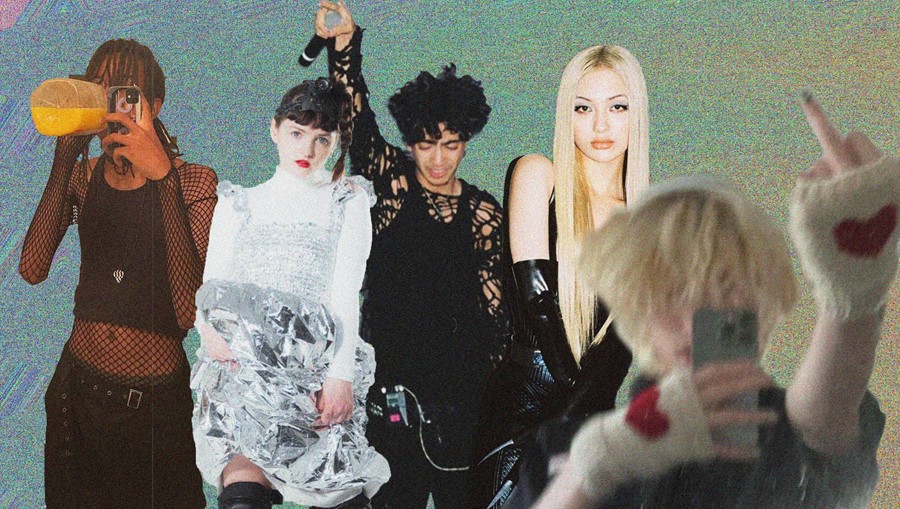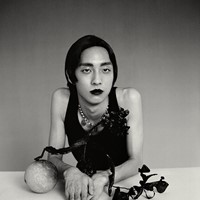What’s hyperpop? What’s digicore? Artists quinn, daine, and Babii settle the score once and for all
“Hyperpop is a simulation,” reads the text that accompanies Spotify’s now-infamous playlist. Launched in 2019, following the unlikely popularity of 100 gecs, the hyperpop playlist was originally meant to platform the extremely online strain of experimental music that critics like to call hyperpop. Born on SoundCloud via Discord servers and Minecraft channels, the sound is maximalist, chaotic, and lo-fi, with many of the original artists in their teens or early twenties. In an article I wrote last year, 23-year-old artist Alice Gas described the music as “being made by kids in their bedrooms with mics and FL Studio”.
Since then, however, the word has since become a catch-all phrase for any and all forms of extreme pop music, from the glossy sounds of PC Music and the AutoTuned croons of Drain Gang, to the death glitch screams of Alice Glass and Arca’s cyborgian lullabies. Sonically, you’d be hard pressed to find any internet-born music made in the last decade that hasn’t been retroactively brandished as hyperpop. The music jumps from absurdist pop to Soundcloud rap and intimate experimentalism – a mix so seemingly disparate that the only thing bringing them together is their knack at pushing the pop envelope.
If the word ‘simulation’ connotes an imitation of something, then ‘hyperpop’ is both a simulation of itself and the music it claims to represent. It’s a nebulous term, encompassing a huge range of styles, sounds, and scenes that seem bound solely by their propensity towards the extreme. Industry heads love it, artists hate it. In less than two years, it’s gone from genre du jour to genre du don’t – it’s very mention is enough to elicit eye rolls from anyone involved. “It feels as though anyone pushing the boundaries in electronic pop right now is being labeled ‘hyperpop’,” says London artist twst. “I imagine it can be frustrating for people who feel like they're being put into a box, and one that's specifically being curated by corporate hands since ‘hyperpop’ is a Spotify-coined term.”
Almost all of those given the label have grown disillusioned with the term, or grown irritated by its constraints. For example, a press release for 18-year-old hyperpop breakout midwxst’s Back in Action EP urged critics to steer clear of the term. “He’s part of this group of young kids leading this new subset of music… but he’s definitely not boxed into the hyperpop sound and on his new music he flows beyond the genre,” it read.
The fact that no one really knows what hyperpop is feeds into its nebulous nature. “No one knows where Spotify got the ‘Hyperpop’ name from,” umru, an artist signed to PC Music, tells me.
To make things more confusing, Apple launched its own version of hyperpop, named glitchcore, following the success of the original Spotify playlist. After growing frustrated by these made-up terms and bottom-down corporate branding exercises, artists – like angelus, d0llywood, midwxst, who had all previously been categorised as hyperpop – took matters into their own hands, choosing the term digicore instead. As 16-year-old producer d0llywood put it at the time, “We’re not PC Music, we’re not glitchcore. We’re hyper kids making pop. The pop is loud, it’s hyper.”
“Digicore was a bit of a joke at first until people started liking that title better than hyperpop” – quinn
“Digicore was a bit of a joke at first until people started liking that title better than hyperpop,” says quinn, the 17-year-old producer who became the face of hyperpop in 2020, after her breakout track “i dont want that many friends in the first place” amassed tens of millions of streams and saw her become the first artist from her SoundCloud scene to appear on the cover of Spotify’s playlist. “It did (attract) people who were pissed at the fact nobody could find a name (for their) the music. But, over the years, that’s died down due to the schisms between styles that evolved from that time. There are a lot of artists who get umbrellaed under hyperpop when they fall more so under experimental – but that’s mostly due to nobody knowing what labels as either of the two.”
Quinn describes hyperpop as having a more polished sound: “Saw waves, metallic sounds, soft synths, the whole nine”. Digicore, in contrast, is “a lot dirtier, with unmastered soundscapes and distorted 808s that usually overtake the entire song”. (That said, Quinn has since rejected both terms completely, going as far as to delete all of the associated songs from her Soundcloud page).
Kuru, a 16-year-old producer who came up in the hyperpop scene alongside the likes of fellow Soundcloud artists d0llywood1, angelus, Blackwinterwells, waifu, MISOGI, and ginseng, describes the shift from hyperpop to digicore as less of a sound change, more artists getting fed up with the label put onto their work. “Hyperpop has the wonkiest combinations of sounds,” he explains. “You’d have people mainly just on the cloud rap side getting grouped in with indie pop and electronic artists, and it was a confusing ordeal, because that term fit so many people. I think digicore was just more of a shift towards describing artists and sounds that felt more homemade and raw and less professional and poppy.”
“To a lot of people, (hyperpop is) a bit of a buzzword to describe anything with a lot of Autotune, but to people part of specific online spaces, it’s a broad word used for ease to describe a certain ecosystem of artists,” adds daine. Following the release of her Dylan Brady-produced single “Boys Wanna Txt” last year, the Melbourne artist became one of the first Australians to grace the cover of Spotify’s Hyperpop playlist. Her music, a moody blend of ethereal soundscapes, introspective lyrics, and harsh trap beats, is inspired by 00s midwest emo movement, as well as emo rappers like Lil Peep and Wicca Phase Springs Eternal. Despite not identifying as hyperpop, she runs a bi-monthly online party Nocturne, which features the whos-who of the hyperpop and digicore communities, from Charli XCX to umru, Alice Gas to ericdoa. “I don’t think there’s clear parameters for either of these genres, and the increased use of ‘digicore’ as a descriptor is probably born from how increasingly loose the term ‘hyperpop’ is,” she adds. “But at the end of the day most of the names who are most strongly associated with these genre labels come from very similar online spaces.”
“One day people will move on from it and it won’t be relevant anymore and I wouldn’t want to melt away with the hyperburg” – Babii
One of the biggest problems facing hyperpop is that it’s essentially trying to group together artists whose music resists classification. “I think anyone who gets thrown into a category or labeled as a stereotype is going to want to get out of it because it kinda erases your uniqueness or identity to a certain extent, you become part of a crowd rather than an individual,” says Babii. “One day people will move on from it and it won't be relevant anymore and I wouldn’t want to melt away with the hyperburg.”
The British producer’s 2021 album MiiRROR brings forth a visceral world of angel dragons and demons, which serve as metaphors for her chaotic childhood and ongoing struggle with maternal figures. Despite featuring the so-called hallmarks of hyperpop – heavily processed vocals give the songs a cyborgian quality, while metallic percussion adds to the synthetic mood – the music is also soft and delicate, an intimate work that, like a mirror, demands reflection from its listener. Babii reflects, “I struggle with being part of it sometimes because my music is so personal and full of my deepest secrets and there are a lot of parts of hyperpop that are a play on jokes and memes and it’s a bit frightening being so vulnerable in a place like that.”
The British producer’s 2021 album MiiRROR brings forth a visceral world of angel dragons and demons, which serve as metaphors for her chaotic childhood and ongoing struggle with maternal figures. Despite featuring the so-called hallmarks of hyperpop – heavily processed vocals give the songs a cyborgian quality, while metallic percussion adds to the synthetic mood – the music is also soft and delicate, an intimate work that, like a mirror, demands reflection from its listener. Babii reflects, “I struggle with being part of it sometimes because my music is so personal and full of my deepest secrets and there are a lot of parts of hyperpop that are a play on jokes and memes and it’s a bit frightening being so vulnerable in a place like that.”
Since its initial boom, many of the young artists originally slated as hyperpop have gone on to have successful careers that transgress the limits of the term. Quinn’s 2021 debut drive-by lullabies moves away from the saccharine tone of previous tracks, instead favouring elements of dark ambient and drum’n’bass. Glaive, another of the teen breakouts from the scene, has eschewed the bedroom-produced chiptune melodies of his earlier work in favour of frenetic pop and sleek production. “I think that the word hyperpop has become a bit oversaturated,” he tells me over email. “I've definitely started to drift away from that community because now I feel like I make more pop music.”
It was only a matter of time until the hyperpop community would begin to grow weary of its limits – especially as many of the artists behind the initial boom have grown older and gained worldwide recognition (both glaive and frequent collaborator ericadoa are now signed to Interscope Records). Nowadays, the term feels more like a corporate branding exercise than a creative flex, begging the question: is it time to burst the bubble and move on?




